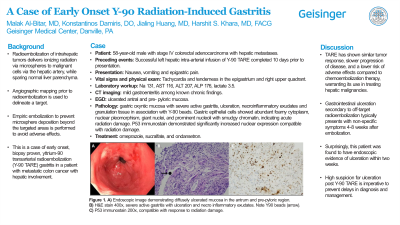Monday Poster Session
Category: Stomach
P3377 - A Case of Early Onset Y-90 Radiation-Induced Gastritis
Monday, October 28, 2024
10:30 AM - 4:00 PM ET
Location: Exhibit Hall E

Has Audio

Malak Al-Bitar, MD
Geisinger Health System
Danville, PA
Presenting Author(s)
Malak Al-Bitar, MD1, Konstantinos Damiris, DO2, Jialing Huang, MD1, Harshit S.. Khara, MD, FACG2
1Geisinger Health System, Danville, PA; 2Geisinger Medical Center, Danville, PA
Introduction: Radioembolization of intrahepatic tumors delivers ionizing radiation via microspheres to malignant cells via the hepatic artery, while sparing normal liver parenchyma. Angiographic mapping prior to radioembolization is used to delineate a target. Empiric embolization to prevent microsphere deposition beyond the targeted areas is performed to avoid adverse effects such as endothelial injury and subsequent ulceration of the gastrointestinal tract. This is a case of early onset, biopsy proven, yttrium-90 transarterial radioembolization (Y-90 TARE) gastritis in a patient with metastatic colon cancer with hepatic involvement.
Case Description/Methods: A 58-year-old male with stage IV colorectal adenocarcinoma with hepatic metastases presented with nausea, vomiting and epigastric pain ten days after successful visceral and hepatic angiography prior to Y-90 TARE. Left hepatic intra-arterial infusion of Y-90 TARE was completed without complications. Vital signs and physical exam were notable for tachycardia and tenderness in the epigastrium and right upper quadrant. Laboratory workup was significant for sodium 131, AST 116, ALT 207, alkaline phosphatase 176, and lactate 3.5. CT imaging demonstrated mild gastroenteritis among known chronic findings. Esophagogastroduodenoscopy was pursued, displaying ulcerated antral and pre- pyloric mucosa (Figure 1A). Biopsy revealed gastric oxyntic mucosa with severe active gastritis, ulceration, necroinflammatory exudates and granulation tissue in association with Y-90 beads (Figure 1B). Gastric epithelial cells showed abundant foamy cytoplasm, nuclear pleomorphism, giant nuclei, and prominent nucleoli with smudgy chromatin, indicating acute radiation damage. P53 immunostain demonstrated significantly increased nuclear expression compatible with radiation damage (Figure 1C). Overall histomorphology was typical of acute Y-90 TARE-induced radiation gastritis. Treatment included omeprazole, sucralfate, and ondansetron.
Discussion: TARE has shown similar tumor response, slower progression of disease, and a lower risk of adverse effects compared to chemoembolization therapy, warranting its use in treating hepatic malignancies. Gastrointestinal ulceration secondary to off-target radioembolization typically presents with non-specific symptoms 4-8 weeks after embolization. Surprisingly, this patient was found to have endoscopic evidence of ulceration within two weeks. High suspicion for ulceration post Y-90 TARE is imperative to prevent delays in diagnosis and management.

Disclosures:
Malak Al-Bitar, MD1, Konstantinos Damiris, DO2, Jialing Huang, MD1, Harshit S.. Khara, MD, FACG2. P3377 - A Case of Early Onset Y-90 Radiation-Induced Gastritis, ACG 2024 Annual Scientific Meeting Abstracts. Philadelphia, PA: American College of Gastroenterology.
1Geisinger Health System, Danville, PA; 2Geisinger Medical Center, Danville, PA
Introduction: Radioembolization of intrahepatic tumors delivers ionizing radiation via microspheres to malignant cells via the hepatic artery, while sparing normal liver parenchyma. Angiographic mapping prior to radioembolization is used to delineate a target. Empiric embolization to prevent microsphere deposition beyond the targeted areas is performed to avoid adverse effects such as endothelial injury and subsequent ulceration of the gastrointestinal tract. This is a case of early onset, biopsy proven, yttrium-90 transarterial radioembolization (Y-90 TARE) gastritis in a patient with metastatic colon cancer with hepatic involvement.
Case Description/Methods: A 58-year-old male with stage IV colorectal adenocarcinoma with hepatic metastases presented with nausea, vomiting and epigastric pain ten days after successful visceral and hepatic angiography prior to Y-90 TARE. Left hepatic intra-arterial infusion of Y-90 TARE was completed without complications. Vital signs and physical exam were notable for tachycardia and tenderness in the epigastrium and right upper quadrant. Laboratory workup was significant for sodium 131, AST 116, ALT 207, alkaline phosphatase 176, and lactate 3.5. CT imaging demonstrated mild gastroenteritis among known chronic findings. Esophagogastroduodenoscopy was pursued, displaying ulcerated antral and pre- pyloric mucosa (Figure 1A). Biopsy revealed gastric oxyntic mucosa with severe active gastritis, ulceration, necroinflammatory exudates and granulation tissue in association with Y-90 beads (Figure 1B). Gastric epithelial cells showed abundant foamy cytoplasm, nuclear pleomorphism, giant nuclei, and prominent nucleoli with smudgy chromatin, indicating acute radiation damage. P53 immunostain demonstrated significantly increased nuclear expression compatible with radiation damage (Figure 1C). Overall histomorphology was typical of acute Y-90 TARE-induced radiation gastritis. Treatment included omeprazole, sucralfate, and ondansetron.
Discussion: TARE has shown similar tumor response, slower progression of disease, and a lower risk of adverse effects compared to chemoembolization therapy, warranting its use in treating hepatic malignancies. Gastrointestinal ulceration secondary to off-target radioembolization typically presents with non-specific symptoms 4-8 weeks after embolization. Surprisingly, this patient was found to have endoscopic evidence of ulceration within two weeks. High suspicion for ulceration post Y-90 TARE is imperative to prevent delays in diagnosis and management.

Figure: Figure 1. A) Endoscopic image demonstrating diffusely ulcerated mucosa in the antrum and pre-pyloric region. B) H&E stain 400x, severe active gastritis with ulceration and necro inflammatory exudates. Note Y90 beads (arrow). C) P53 immunostain 200x, compatible with response to radiation damage.
Disclosures:
Malak Al-Bitar indicated no relevant financial relationships.
Konstantinos Damiris indicated no relevant financial relationships.
Jialing Huang indicated no relevant financial relationships.
Harshit Khara: Boston Scientific – Consultant. Castle Biosciences – Consultant. ConMed – Consultant. Cook Medical – Consultant. Medtronic – Consultant. Neptune Medical – Consultant. Olympus America – Consultant. Pentax – Consultant.
Malak Al-Bitar, MD1, Konstantinos Damiris, DO2, Jialing Huang, MD1, Harshit S.. Khara, MD, FACG2. P3377 - A Case of Early Onset Y-90 Radiation-Induced Gastritis, ACG 2024 Annual Scientific Meeting Abstracts. Philadelphia, PA: American College of Gastroenterology.
